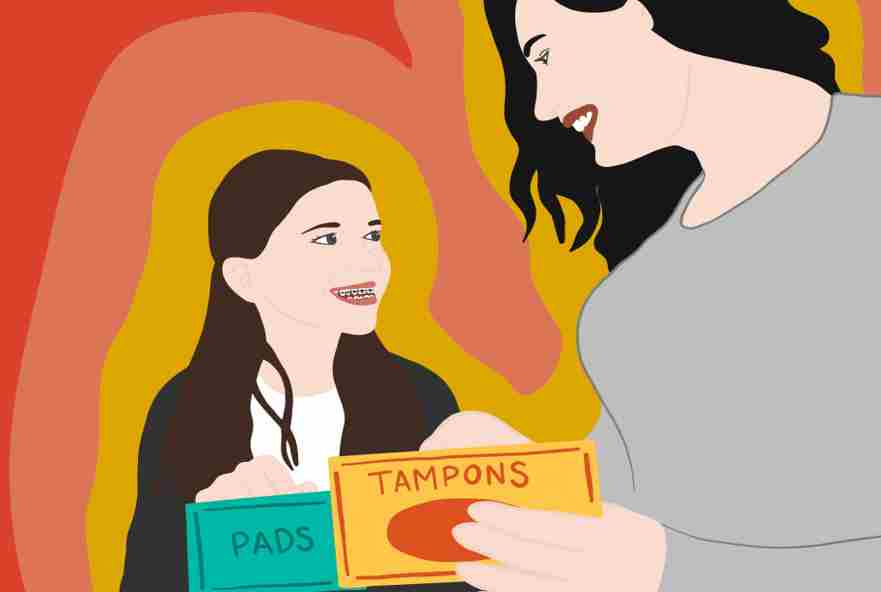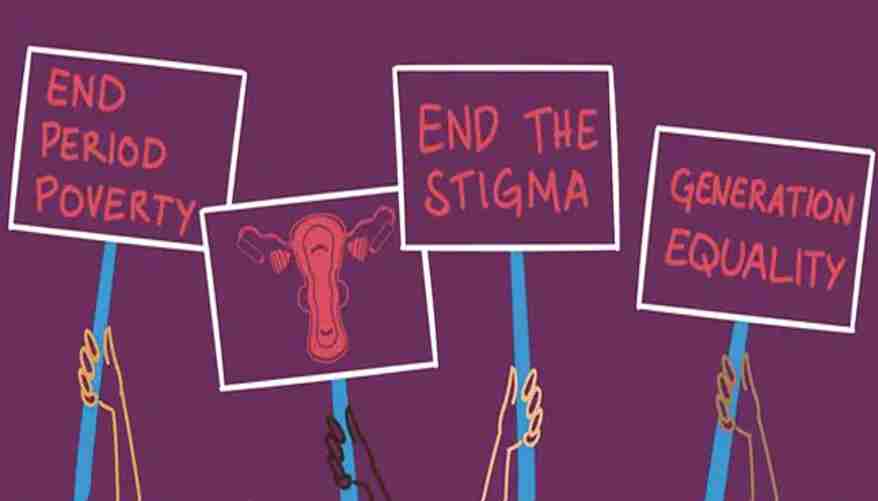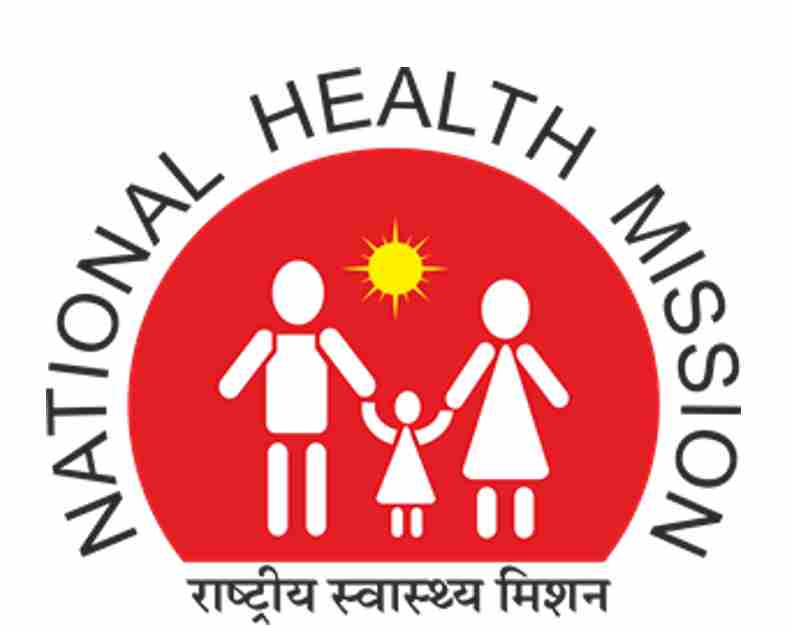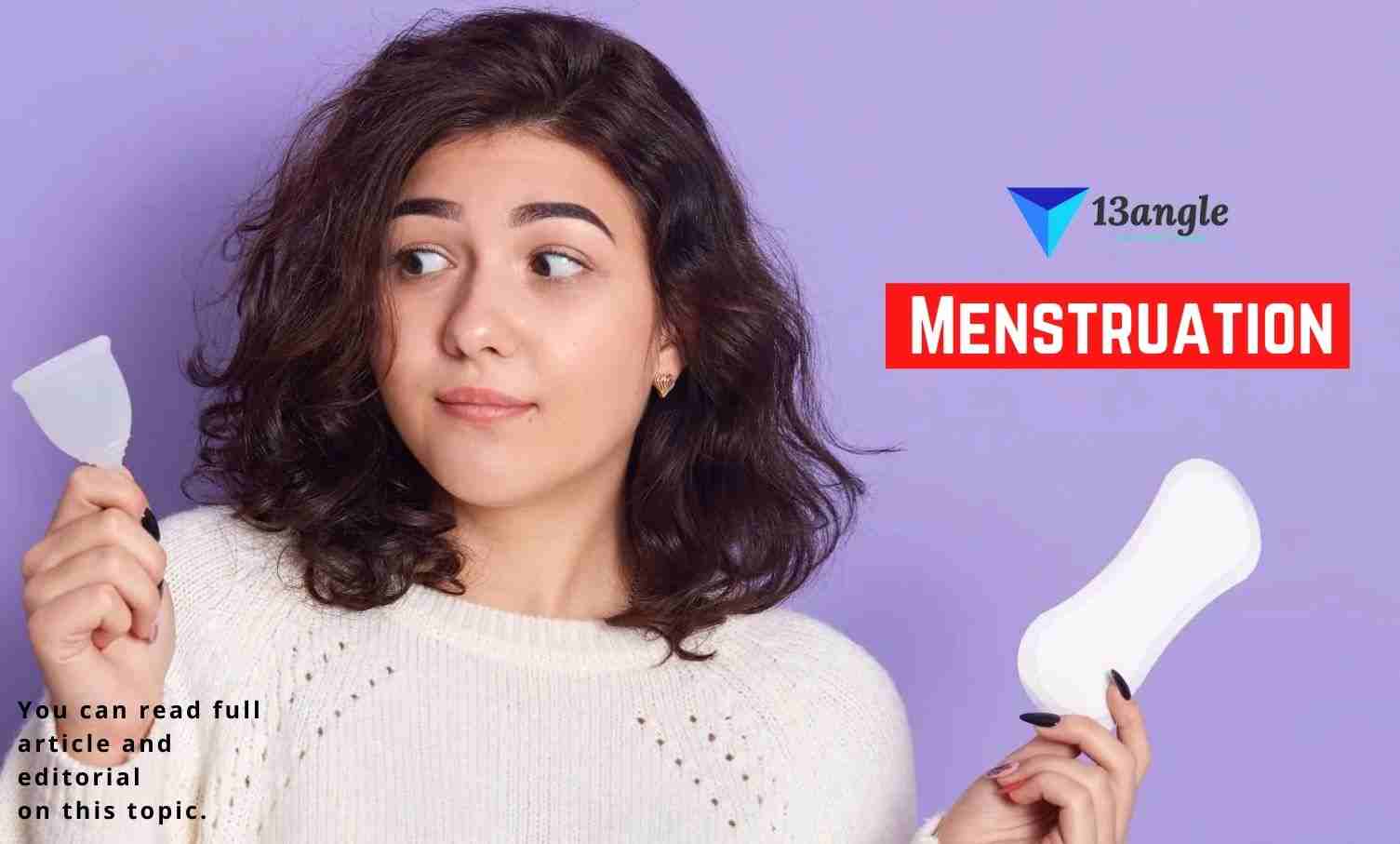- Umang Sagar
- 1 Comment
- Health, Recent article
Menstruation

Introduction
For most women, menstruation is a natural and healthy part of life. Periods, or menstruation, are a type of vaginal bleeding that happens as part of a woman’s monthly cycle. Menstruation begins throughout adolescence (at menarche) in girls aged 12-16 and ends permanently in women aged 44-49 at menopause.
The female body prepares for conception in roughly monthly cycles throughout a woman’s reproductive life. The uterus, or womb, removes its lining if no pregnancy develops. Menstrual blood is made up of both blood and tissue from the uterus. It exits the body via the vaginal canal.

The menstrual cycle is controlled by a complex orchestra of hormones, produced by two structures in the brain, the pituitary gland, and the hypothalamus along with the ovaries. The menstrual cycle includes several phases. The exact timing of the phases of the cycle is a little bit different for every woman and can change over time. The menstrual cycle is regulated by hormones. Luteinizing hormone and follicle-stimulating hormone, which are produced by the pituitary gland, promote ovulation and stimulate the ovaries to produce estrogen and progesterone. Estrogen and progesterone stimulate the uterus and breasts to prepare for possible fertilization.
The menstrual cycle is regulated by the complex interaction of hormones: luteinizing hormone, follicle-stimulating hormone, and the female sex hormones estrogen and progesterone.
The menstrual cycle has three phases:-
- Follicular (before the release of the egg)
- Ovulatory (egg release)
- Luteal (after egg release)

Cycle Days
| Days 1-5 | The first day of menstrual bleeding is considered Day 1 of the cycle. Your period can last anywhere from 3 to 8 days, but 5 days is average. Bleeding is usually heaviest on the first 2 days. |
| Days 6-14 | Once the bleeding stops, the uterine lining (also called the endometrium) begins to prepare for the possibility of a pregnancy. The uterine lining becomes thicker and enriched in blood and nutrients. |
| Day 14-25 | Somewhere around day 14, an egg is released from one of the ovaries and begins its journey down the fallopian tubes to the uterus. If sperm are present in the fallopian tube at this time, fertilization can occur. In this case, the fertilized egg will travel to the uterus and attempt to implant in the uterine wall. |
| Days 25-28 | If the egg was not fertilized or implantation does not occur, hormonal changes signal the uterus to prepare to shed its lining, and the egg breaks down and is shed along with the lining. The cycle begins again on Day 1 menstrual bleeding. |
Comprehensive Explanation Of The Menstrual Cycle
1. Follicular Phase (Days 1-14)
This phase of the menstrual cycle lasts between 1 to 14 days. The first day of vivid red bleeding is Day 1, and ovulation marks the conclusion of this period. While menstrual bleeding occurs in the early stages of this phase, the ovaries are preparing to ovulate once more. FSH – follicle-stimulating hormone – is released by the pituitary gland (placed near the base of the brain). Several ‘follicles’ rises to the surface of the ovary as a result of this hormone. Each of the fluid-filled “bumps” contains an egg. One of these follicles eventually becomes dominant, and a single mature egg develops within it; the other follicles shrink back. The maturing follicle produces the hormone estrogen, which increases over the follicular phase and peaks in a day or two prior to ovulation. The lining of the uterus (endometrium) becomes thicker and more enriched with blood in the second part of this phase (after menstruation is over), in response to increasing levels of estrogen. High levels of estrogen stimulate the production of gonadotropin-releasing hormone (GnRH), which in turn stimulates the pituitary gland to secrete luteinizing hormone (LH). On about day 12, surges in LH and FSH cause the egg to be released from the follicle. The surge in LH also causes a brief surge in testosterone, which increases sex drive, right at the most fertile time of the cycle. At the beginning of the follicular phase, the lining of the uterus (endometrium) is thick with fluids and nutrients designed to nourish an embryo. If no egg has been fertilized, estrogen and progesterone levels are low. As a result, the top layers of the endometrium are shed, and menstrual bleeding occurs.
The pituitary gland marginally boosts its synthesis of the follicle-stimulating hormone during this period. The growth of 3 to 30 follicles is then stimulated by this hormone. Each follicle is home to an egg. As the level of this hormone drops later in the phase, only one of these follicles (known as the dominant follicle) continues to develop. It starts producing estrogen right away, and the other exciting follicles start to break down. Increased estrogen also starts to prepare the uterus and encourages the release of luteinizing hormone.
This phase ends when the level of luteinizing hormone increases dramatically (surges). The surge results in the release of the egg (ovulation) and marks the beginning of the next phase.
2. Ovulatory Phase (Day 14)

The mature egg is released around day 14 as a result of an increase in LH and FSH the day before. If sperm are present, the egg enters the fallopian tube after being released, where fertilization may occur. The egg disintegrates after roughly 24 hours if it is not fertilized. The follicle closes over when the egg is discharged, and this is known as the corpus luteum. When the amount of luteinizing hormone rises, the ovulatory phase begins. The dominant follicle is stimulated by luteinizing hormone to expand from the ovary’s surface and eventually burst, releasing the egg. Follicle-stimulating hormone levels grow to a lower extent. The purpose of the follicle-stimulating hormone rise is unknown.
The ovulatory phase usually lasts 16 to 32 hours. It ends when the egg is released, about 10 to 12 hours after the surge in the level of luteinizing hormone. The egg can be fertilized for only up to about 12 hours after its release. The surge in luteinizing hormone can be detected by measuring the level of this hormone in urine. This measurement can be used to determine when women are fertile. Fertilization is more likely when sperm are present in the reproductive tract before the egg is released. Most pregnancies occur when intercourse occurs 3 days before ovulation.
Some women have a dull discomfort on one side of their lower abdomen around the time of ovulation. The pain is referred to as mittelschmerz (literally, middle pain). The discomfort might last anywhere from a few minutes to many hours. The discomfort normally occurs on the same side as the ovary that delivered the egg, although the exact cause is uncertain. The discomfort may occur before or after the follicle ruptures and it may not happen in every cycle. Egg release appears to be random and does not appear to alternate between the two ovaries.
The remaining ovary produces one egg every month if one ovary is removed.
3. Luteal Phase (Days 14-28)

FSH and LH levels fall after the egg is released. Progesterone is produced by the corpus luteal. The corpus luteal continues to generate progesterone after fertilization, preventing the uterine lining from being lost. The corpus luteal disintegrates if fertilization does not occur, lowering progesterone levels and signaling the uterine lining to shed. After ovulation, the luteal phase begins. It lasts around 14 days (unless fertilization happens) and stops right before menstruation.
During most of the luteal phase, the estrogen level is high. Estrogen also stimulates the endometrium to thicken.
The increase in estrogen and progesterone levels causes milk ducts in the breasts to widen (dilate). As a result, the breasts may swell and become tender.If the egg is not fertilized or if the fertilized egg does not implant, the corpus luteal degenerates after 14 days, levels of estrogen and progesterone decrease, and a new menstrual cycle begins.
When Should I Expect My First Period?

Between the ages of 10 and 14, most females have their first period, with an average age of little over 12 years old. It’s difficult to predict when your first period will occur. It normally occurs two years after the first indications of puberty (usually breast growth) and a year after pubic hair begins to grow. In the months coming up to your menstruation, you may notice a white or yellowish vaginal discharge.
There are numerous factors that are thought to influence the age of the first period, including:-
- Nutrition
- Exercise
- Genetics
- Ethnicity
- Body size
- Geography (northern climates vs. southern climates)
- Family income, size, structure
- Parental education
- Illness and stress
- Over time, the average age of the first period has decreased. The average age of the first period in the United States was between 14 and 15 years old in 1900. The lowering age of menstruation onset appears to have reached a halt around 12 years old.
How Is Menstruation Related To Human Rights?

Human rights are rights that every human being possesses as a result of his or her dignity as a human being. Menstruation is inextricably linked to human dignity; when individuals lack access to clean bathing facilities as well as safe and effective methods of managing their menstrual hygiene, they are unable to manage their periods with dignity. Teasing, marginalization, and humiliation associated with menstruation also violate the notion of human dignity.
Menstruation may become a period of deprivation and stigma for women due to gender inequality, extreme poverty, humanitarian crises, and damaging customs, all of which can jeopardize their enjoyment of basic human rights. This is true for menstruating women and girls, as well as transgender males and no binary people.
What Are Common Myths And Taboos About Menstruation? How Do They Affect The Status Of Women?

Menstrual taboos have existed and still exist, in many or most cultures. Around the world and throughout history, misconceptions about menstruation have led to women’s and girls’ exclusion from all kinds of roles and settings – everything from leadership positions to space travel. Below is a non-exhaustive list of menstruation myths and taboos, as well as their impact on women and girls.
Myth: Menstruation is dirty or dangerous
Reality: it’s not
Myth: Certain foods are off-limits to menstruating women and girls
Reality: citric foods are often restricted to menstruating women, but the fact is they do not correlate
Myth: Menstruation indicates readiness for marriage and sex
Reality: absolute no, women will be when she is ready on her on terms and consent
Myth: Menstruation limits women’s abilities
Reality: there is no comparison of a women’s ability to any work regardless of she is being menstruated or not
Myth: All women are moody when they menstruate
Reality: It’s a subjective opinion, does not apply to all
Taboo: Menstruation should not be discussed publicly
Reality: we should discuss general topics like menstruating and sex to make it more comfortable to understand. As this is a part of everyone life’s
Myth: Menstruation is a women’s issue only
Reality: a big no
Is Menstruation Bad For The Environment?
No, menstruation is not bad for the environment. However, products used to manage menstruation can have a negative impact on the environment, depending on the product and the way it is disposed of.
Menstrual products such as tampons and pads often contain plastics and chemicals that are bad for the environment. The time it takes for them to degrade in a landfill is centuries longer than the lifespan of a woman. The manufacturing process to produce menstrual products also has environmental consequences.
More environmentally friendly options include reusable menstrual cups as well as reusable and/or biodegradable pads.
Are Menstrual Products Bad For Your Health?
In general, No. However, there are possible health impacts to consider.
The use of highly absorbent tampons has been associated with (TSS) toxic syndrome life-threatening conditions, but these cases are rare. Frequently changing tampons greatly lowers the risk of TSS.
How Will The Covid-19 Pandemic Affect People's Ability To Manage Their Menstruation?
- Communities around the world are feeling the numerous and overlapping effects of the COVID-19 pandemic. These may have a significant impact on people’s life. Safely and with dignity:
- Gaps in the provision of water and sanitation services, such as lack of sewage maintenance or disruption of water supply, will have a direct impact on people’s ability to manage their menstruation.
- Stock-outs and supply chain disruptions mean that communities could lose access to menstrual pads, tampons, and other menstrual materials.
- People who may be quarantined because they have either contracted or met someone who has contracted COVID-19 may have limited access to menstrual products or running water.
- Financial stress on families who may be underemployed due to the pandemic may lead to households prioritizing other basic needs like food or household bills over menstruation supplies.
- Increased prices of menstrual health supplies due to increased demand, panic-buying or disrupted supply chains may leave some without supplies, or without the supplies of their choice.
- Lack of knowledge of one’s own menstruation and menarche may contribute to stress and anxiety. The pandemic may limit access to critical information related to menstrual health due to disruption of regular health services, school closures, limited access to technology, and suspension of community-based programming.
Government Steps To Improve Menstruation Health

National Health Mission
In rural regions, the Ministry of Health and Family Welfare has launched a program to promote menstruation hygiene among teenage females aged 10 to 19. In rural regions, the Ministry of Health and Family Welfare has launched a program to promote menstruation hygiene among teenage females aged 10 to 19. The initiative was first introduced in 2011 in 107 chosen districts across 17 states, where rural teenage girls were given a bag of six sanitary napkins dubbed “Freedays” for Rs. 6. Since 2014, funding under the National Health Mission has been granted to States/UTs for the decentralized purchase of sanitary napkin packs for distribution to rural teenage girls at a discounted rate of Rs 6 per pack
The ASHA will continue to be responsible for the distribution, receiving an incentive @ Rs 1 per pack sold and a free pack of napkins every month for her own personal use. She would hold monthly sessions for teenage girls in Aanganwadi Centres or other similar venues to focus on the topic of menstrual hygiene and to discuss other related SRH concerns.
A variety of IEC materials have been developed around MHS, using a 360-degree approach to raise awareness among adolescent girls about safe and hygienic menstrual health practices. These materials include audio, video, and reading materials for adolescent girls, as well as job-aids for ASHAs and other field-level functionaries for communicating with adolescent girls.
The Bollywood Film Breaking The Stereotype And Taboo Around Periods

1.Padman

2. Period End Of Sentence

3. Phullu
Top Influencers Working Towards Improving Menstrual Health
1. Seema Anand @seemaanandstorytelling
Seema Anand is a London-based mythologist and narrative practitioner. She is an acknowledged authority on the Kama Sutra and lectures on Eastern Erotology, Tantric philosophy, the Mahavidyas, Mahabharata, and Bhagavad Gita, among other subjects.
2. Urmila Chanam
Menstrual Health Activist, Founder & CEO Breaking the Silence Worldwide Foundation, Ambassador World Pulse, Journalist & Columnist, Laadli Media Awardee.
3. Tanaya Narendra @dr_cuterus
Dr. Tanaya is an award-winning, internationally trained medical doctor, embryologist, and scientist who is passionate about medical education.
4. Diipa Khosla
Indian influencer Diipa Khosla partnered with UNICEF on their Red Dot campaign to raise awareness around menstruation and sexual health
Top 13 Facts About Menstruation
Period pain is caused by contractions in the uterus. The blood vessels in the muscle wall are compressed by the contractions, which cut off blood supply to the womb, starving it of oxygen and adding to the discomfort.
Menstruation may have led to humanity’s sense of time as most early lunar calendars were based on the length of a woman’s menstrual cycle.
On average a woman menstruates for about 7 years during their lifetime that is more than 400 periods in her lifetime.
Sleeping with a nightlight can help in regulating your cycle.
The sound of your voice changes during your menstruation time.
Scientific techniques prove that menstruation in no way contaminates food, so you can enter the kitchen and prepare the food with general hygiene.
Approximately 5 to 12 tablespoons of blood is lost on average during menstruating.
Orgasms can make your crams feel better and sex during menstruation help in calming down the contracted tissues and relieving the cramps.
9 Before her mission in 1993, a NASA engineer asked- Sally Ride if she would need 100 tampons for the week of periods in space.
You can still get pregnant if you are on your periods, but it’s not as likely.
Drinking alcohol during one’s period tends to make menstrual pain last longer.
Stress can cause menstrual cycles to become more painful, become longer or shorter, or to totally stop.
Other reasons the menstrual cycle can stop or alter include exercising too much, being obese, and certain contraception having an effect on someone’s specific body.






[…] Menstruation is a natural organic manner experienced by means of many people assigned to women at delivery. However, it’s miles essential to recognize that now not all those who menstruate identify as women. Transgender and non-binary individuals, whose gender identities do not align with their assigned sex, frequently face challenges and considerations with regard to menstrual fitness. In this text, we can delve into the intricacies of menstruation for transgender and non-binary people, losing mild on their stories, desires, and the significance of fostering inclusive and supportive surroundings. […]